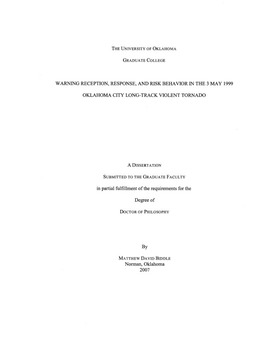| dc.description.abstract | On 03 May 1999, a long-track violent tornado killed 40 people and injured ∼ 800 in and near Oklahoma City, Oklahoma. Following the disaster, surveys were collected from persons residing or working within the damaged areas regarding their actions, and the actions of those in their care or company. Similar data were obtained for fatalities. The purpose of the field operations were to collect geographical, demographical, behavioral, and attitudinal information from a sample of survivors, and to the fullest extent possible, for all decedents. Respondent data were analyzed for patterns in warning access, source, compliance, and lead time, as well as for geographical and cultural variables such as shelter availability, tornado hazard perception, and opinions about warning systems. Goals were to catalog significant differences between survivor and decedent traits to identify successful warning operations and media practices; to delineate the warning environment as characterized by societal risk perception and response; and to compare these findings to previous research. Situational risk factors for death included: living in a mobile home or unincorporated area; living near the starting point of the tornado path; and being physically disabled, elderly, or of lower socioeconomic strata. Cognitive risk factors for death included misjudging the tornado path or severity in spite of receiving warnings; choosing inadequate shelter; and attempting to flee too late. Risk factors for survival included access to televised warnings and receiving warnings via telephone; sheltering below ground or fleeing the path; and general familiarity with weather information and local geography. Risk factors for survival did not substantially include warnings from siren systems or NOAA Weather Radio. The performance of tornado detection and surveillance systems, Integrated Emergency Management, and the timely dissemination of detailed warnings via electronic media were all important in holding the death toll down. Yet, none of these were able to completely mitigate the risk to certain highly vulnerable populations or individuals. Warning system efficacy for this extreme event, having occurred among a large population with relatively-high severe weather awareness is explored, along with some unusual findings regarding warning communication and evacuation behavior. | en_US |
